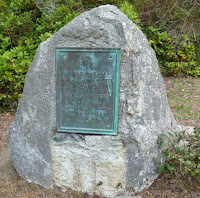 |
| Lies Across America in the Ocean Shores Library |
 |
| Fort Chehalis Marker photo by John Stanton 16 Sep 2015 |
The museum further elaborates on the "wive's tale" of the Indian threat with a dressed up artifact and the accompanying story. The museum goes far beyond the half truth on the DAR monument.
 |
| Photo of Stove Door taken on April 24, 2021. The gold paint is probably a fanciful addition |
Unearthed at Old Fort Chehalis, Westport, Washington.
Top loading wood stove.
This pencil sketch gives a pretty good idea of how this stove looked in 1860 at Old Fort Chehalis. Evidence from the recovered top tells that it turned sideways to put in more wood and that there was no end door. The top exhibited here was exhumed from the sand dunes at the Old Fort site and must have been buried for more than 100 years. It was badly rusted and no other parts were recovered.
Fort Chehalis was established to protect the citizens from Indian attacks. During the Fort's existence, not a single shot was fired at the hostile Indians.
 |
| Description of Fort Chehalis - Protecting us from "Indian attacks." Indeed! |
To make a long story short, white settlers started moving to what became Westport around 1850, and by 1853, the Chehalis Tribe was devasted by disease, in an event known as "the big sick." That story is related here. In 1855, the Indians were called in by Governor Isaac Stevens to sign a treaty similar to the Point Elliott Treaty. The Chehalis, whose name means "sand" lived near Westport. Unfortunately, they refused to sign when the LOCATION of their reservation was left unspecified, and being a "non treaty tribe" left them completely at the mercy of the invading white settlers. In 1860, the same year Fort Chehalis was established, they were directed to move to their current reservation, which is related here (along with the land later given away on their reservation). In truth, the so-called hostile indians were mostly gone by the time the fort was built and so it is no wonder that "not a single shot was fired at the hostile Indians."
The DAR Monument was a product of the societal attitudes prevalent around 1929 and it certainly would not make sense to relegate it to some attic or to try to remake it into something more accurate - a fort that was established to force the remaing Indians out of Westport. I hope that when the monument is rededicated, that mention is made that the Indians were actually being removed at the behest of the whites, not that the whites were being protected from the Indians. Perhaps the DAR would also consider joining with the Chehalis Tribe to add a second monument relating what really happened. It'd also be nice if the Westport Maritime Museum considered the implication of soldiers never needing to fire a single shot at "the hostile Indians." Indeed, the book Exploring Washington's Past: A Road Guide to History states:
Few actual functions were performed at Fort Chehalis (at the sandy point just inside today's Westport harbor ) other than Captain Maloney's attempts to enforce laws against selling liquor to native people.
In June 1861 troops were ordered East to fight in the Civil War, and the fort fell silent . Settlers bought most of the buildings and moved them to various sites around the harbor.
The monument is being cleaned by the Robert Gray Chapter of the Daughters of the American Revolution and is scheduled to re-dedicated at Harriett Dorland Municipal Park/Westport City Park on Saturday, May 8 at 2PM.
UPDATE ON July 17:
According to this site on page 17, among other items, states:
Early settlers on the Harbor ranched, farmed, fished, and began lumber businesses. Even though the Chehalis were friendly, the settlers still feared them. Edwin van Sykle recounts that a Grays Harbor settler, Martha Medcalf, remained with her children on the back hill of her property due to fear of an attack. This fear and incidents east of the Cascades prompted the creation of Fort Chehalis by Company A of the 4th Infantry at Chehalis Point (the site of Westport) from February 9, 1860 to June 19, 1861. Fort Chehalis is also known as Port Chehalis. Federal troops were removed from Fort Chehalis after the start of the Civil War. On August 3, 1861 Fort Chehalis buildings were sold. Several of the buildings are still in use in the neighboring community of Hoquiam.

No comments:
Post a Comment